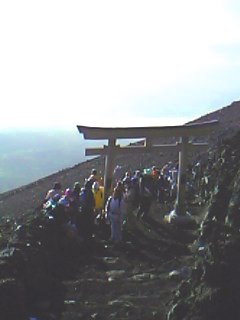The Fujisan expedition: part two
Goraiko and Champagne




Monday 14th August
After a short rest between the stone lions and the torii gate, we clambered up the last few metres to the summit. The sky was now a soft blue and there were only a few clouds to look down upon. Goraiko was approaching. Thousands of people were standing at the edge or sitting on the furthest and highest side of the crater, awaiting the moment when the sun emerged over the horizon. My head was spinning with fatigue and emotion. We hurried to find a suitable vantage point. The top of mount Fuji is not exactly a spiritual place. Luckily I was aware of this after having read about other people's experiences online. The vending machines, souvenir stalls and small eateries, the litter and the public toilets kind of detract from the sense that one might be closer to 'God' up there. The closest I came to having a 'spiritual experience' was coming face to face with the price of a small bottle of Volvic mineral water - 500 yen (2 pounds fifty.) Actually, what I thought was really surreal was that they imported mineral water from the French Alps to sell at the summit of Mt. Fuji which, of course, also has its own source of mineral water bottled by Asahi.
"We will, we will rock you."
As we stood at the edge of the tallest mountain in all of Japan, about as far away from my hometown of Hastings as I could get, Queen's "We will rock you" started blaring out from loudspeakers behind us. "Only in Japan." I heard myself thinking. State of the art cell phones poised, a couple of thousand spectators on the edge of an ancient crater - and there it was. Just like that; a perfect pinkish-orange ball of fire melted through the cloud. It was magical. People were silent for a moment and then there were great cheers. The Japanese tour groups had formed circles and were shouting "banzai, banzai!" (Those familiar with the bizarre and rather amusing Japanese game show of the same name, may know that 'banzai' means 'long life' or 'hoorah!' However, the literal translation means 'ten thousand years of life.') I wish I could say that I had some kind of epiphany at that spectacular moment - some great insight into the meaning of life but, truth be told I didn't. At least not at that juncture. I just stood and watched. It was truly beautiful.
The early Chinese characters for 'Fuji' translate as 'without equal'. Now, I have not climbed many mountains but I knew for certain that this experience was one without equal as far as I was concerned. As I stood at the summit and surveyed the land of the rising sun spread out far below, and rubbed my frozen fingers, I felt torn between two realms of experience; the aesthetic / intellectual and the physical. My mind was barely functioning up there. I had not slept, I was cold and tired and starved of air. Yet I was so excited to be experiencing such a wonder. I tried to let my camera do the work and snapped some pictures in the vain hope that they would capture something I did not have energy for. I so wanted to contemplate the significance of it all but my mind was more concerned with trivial matters such as "I wonder where the rest of the group are? I am cold. I must take some photos. I am hungry. I hope Erika is ok. I should try calling my parents. I wonder how they transport stock up for the vending machines?" And so on.

The peak was slowly flooding with more and more people and after a brief walk to the edge of the crater we decided to find someplace to warm up. Suddenly the ramen huts appeared less of an affront to our Fuji experience, and more a welcome retreat. The sun had risen further into the perfect blue sky and the rocks were positively shimmering in the clear light. Against the sienna and ochre of the ground, the figures scattered about the summit shone in a rainbow of primary colours. Back-packs and anoraks were lit up in the morning sun. Never have I seen such pure colour. We walked back to the row of stalls and shacks and into the warmth of the first hut we came to. There must have been two hundred people in there. Some were asleep but most were huddled together eating steaming bowls of noodle soup, or curry and rice. Our friends Trish and Jarret obviously had had the side idea, for there they were, sat on a bench barely two feet away. I was actually surprised to have found them amongst all the people.
It was about 5.15 am at this point and the sun was streaming in the open sides of the low building. I looked up at the menu that was hand written on a sheet of paper and pinned to the far wall. I don't quite recall what was on offer, but what I do remember was the distinct lack of tempting vegetarian options. Or, more accurately, the lack of vegetarian options altogether. No surprises there though, for Japan doesn't really understand the concept of vegetarianism. There have been times when I have asked whether something is vegetarian and (perhaps because the Japanese find it difficult to say 'no') they say 'yes'. On closer inspection it turns out of course to be stuffed with meat. After pointing this out to them the common response is, "oh it's only a bit. You can pick it out, no?" My friends however assured me that the 'miso-ramen' was in fact meat-free, and in spite of my hesitation I let them order it for me. (I swear the stock for this noodle soup is made from boiled pig's bones though. Yuk.)
As we sat there waiting for our breakfast and gradually warming up, I decided this may be a good time to crack open the champagne. I dug around in my bag and extracted a nicely chilled bottle of Moet and Chandon, which I hoped would receive at least a vague cheer. But no. The glum lot just sat there looking vaguely confused. I tried to explain myself "Look we just climbed a mountain, it is a beautiful morning and I thought it might be nice to drink a toast to our success or to Japan or something. I mean, we made it!!" I peeled off the seal and eased out the cork cautiously. I didn't want to it to launch off and hit one of these 'happy campers' in the face now did I? I took a swig and nearly choked myself. Champagne isn't the best things to drink straight from the bottle. I then passed it to Erika who reluctantly took the tiniest of sips and then proffered it to Trish and Jarret who both declined, with vague looks of disgust upon their faces. I don't think either of them were faring too well. They were suffering from altitude sickness. Jarret complained of having the worst headache of his life which was probably due to the reduced levels of oxygen that was forcing his brain to expand against an immovable skull. At that moment our breakfast arrived: thick noodles swimming in (bone juice?) topped with seaweed and bamboo shoots. I took another gulp of champagne and tried not to feel guilty about being the only one who wasn't suffering for one reason or another and charily poked at the broth with a pair of chopsticks.
After probably the strangest breakfast of my life I decided to go for a walk in search of a phone signal. Trish had slipped out in the direction of the toilets and Jarret and Erika were trying to sleep. I headed back in the direction of the torii gate and found a ledge leading around the entrance to the centre of the earth. Bodies were strewn by the pathside in various stages of torpid recovery. By some miracle I found a spot in which my cell phone had full reception. (Funnily enough when I was at 8th station I had checked my phone and I had lost the signal but could still watch TV on it.) There was something about being able to phone my family in England from the top of Mt. Fuji that was totally preternatural. The isolation you expect to find outside, or in this case, above civilization, barely exists anymore. When civilization can accompany you to the top of a mountain in the form of a small box-like device you have to admit that technology makes the world feel like a much smaller place. Imagine being able to watch TV and call your Mum at some far-flung place that has been considered sacred for centuries; the final destination for pilgrims trying to discover meaning beyond the blinding dogmas of society. However, there was something rather wondrous about making the phone call because although separated geographically, I was able to share something of the experience with them through an invisible connection via a satellite in space. In that respect the event could be likened to a metaphysical union; a spiritual encounter for modern man.
After I hung up I felt strangely empty. I finished my can of oxygen and drank a little more of the French stuff. It had turned out to be a rather lonely champagne breakfast. The sun had warmed the air by a few degrees and as I stared down the mountainside at the meandering vein of climbers heading up, I saw Gareth approaching the torii gate. I went down to greet him and we walked back to the ramen hut together to meet the others. They were still passed out on benches. I left him to recuperate and went in search of a stall that sold postcards. On my way I passed a man with leathery hands sitting by a small fire. I had almost forgotten about getting the final brand for my stick - 'Fuji sunrise 2006' it read. "Such great heights...." The Postal Service track fittingly started going round in my head.... I bought some postcards and in a blur of languor I scrawled some messages. I found it hard to believe that they would actually be posted from the summit but I took a chance and stamped them with the Fuji postmark and forked over my five quid. I traipsed off wondering how often the postman has to make the hike up to collect the mail. What a job. He must be fit.... One week on and I heard that the postcards had indeed arrived in England. So it wasn't a scam after all. Only in Japan would the postal service be efficient enough to deliver mail sent from the tops of mountains nearly 4 km high. I mean you are lucky to receive a postcard sent back from Italy....

By 7:30 am we were set to hit the road. We joined the flow of people heading back down on the Subashiri route. For many people the hike was just beginning. I am glad we didn't do it in the daytime as it would have been far too hot. The trail down was a vicious slant composed of several inches of dirt and grit that you could not walk in a straight line down lest you slipped. Thus started the most excruciating part of the whole adventure. The come down is always the killer. For the first 45 minutes were were walking / sliding together and commenting on the view and the clouds that were billowing up towards us like dry-ice. I clutched my staff in one hand and the remainder of the now warm champagne in the other. The further we descended the further we realised how far we had to go. The nightmare just kept on unfolding beneath us. We must have traversed 30 km in zig-zagging slopes of loose debris. I couldn't believe that we had climbed it. I honestly couldn't believe we had come so high.
Two hours later and my bottle had been discarded and we were now silent, fed up, hot and exhausted beyond belief. The sun had come out again and was burning the right side of my face and arms. At this level I noticed that the slopes were dotted with bright green cabbage-like plants; the only thing tough enough to flourish in such a barren environment. I had had enough. I wanted to get back. I wanted an iced-coffee, a bath and a cool bed. It was all I could think about. To make matters worse I knew that we still had a long way to go before we got back to the bus station, and from there it was going to be a four hour journey back to Tokyo and then there would be the walk from the station to my house. Ouch. I started running down, side on. This proved to be the most effective way of doing it but it took its toll on the ankles.
We rested awhile at the fifth station and got chatting to an Australian couple who were hurrying back to catch a flight from Narita leaving at 8 pm that evening. Blimey I thought, talk about madness! Fancy climbing mount Fuji the night before you fly back to Australia. They probably weren't going to get back to their hotel until 4 pm - and that was if they were quick. We were almost back on the level now and had estimated that the walk from 5th station to the bus stop would not take more than 25 minutes. When we had made the journey the night before through the woodland track it seemed to be an easy walk, but coming back it went on forever. We continued to stumble and run and then collapse on tree stumps to rest - by now we were laughing with delirium and relief that we had almost left that godforsaken mountain behind. I remembered Jason describing how he felt when he made the descent - "It was the only time in my life when I truly felt I could kill someone." It is amazing how the drive to get to the top motivates you to keep on going. Once that goal has been reached the rest of it becomes a painful slog. I remembered the saying "a wise man climbs Fuji once, but only a fool climbs it twice." Before our hike I felt that this was a rather negative thing to say and it didn't really fill me with inspiration. However, now I was a full supporter of the opinion. "Never again" I thought to myself. As we passed the fresh faced string of climbers heading up I wondered what they thought of us. Did we look dismal enough to give them second thoughts? I felt myself staring at the chirpy tour groups that strolled by in their pristine walking boots. (My new white trainers were now orange with dust.) I wanted to scream at them "don't do it! You have no idea about what you are in for!" It actually made me feel sick just thinking about how far they had to go.
Yet, as in life, all things, good and bad, come to an end. The moment you felt was never going to arrive does. Then it is all over, just like that. Now I found myself able to say "I have climbed Mt. Fuji". It has become just another topic to discuss over dinner in an elegant restaurant or in a bar with friends. It was over. Of course there was the bus ride back to the station and the train ride to Tokyo and the long walk home in the afternoon sun, but in a way that is all irrelevant. I slept most of the way anyway. Everyone had recovered from the altitude sickness but were now suffering from aching muscles, sun-burn and sleep deprivation.
I dragged my sorry self back through the quiet streets of Toyoda that run parallel to the train tracks. It was a golden afternoon. Home at last. I can't tell you how good it was to have that shower, collapse onto my bed and fall asleep to the hum of the air conditioning and the roar of the trains outside my window. And so ends my epic blog - I feel almost as exhausted as I did after the hike! Especially considering I had to rewrite most of the second part after I accidentally lost it a couple of nights ago. In a way, it feels as if by writing about it I have climbed it twice. Perhaps that makes me half a fool...





